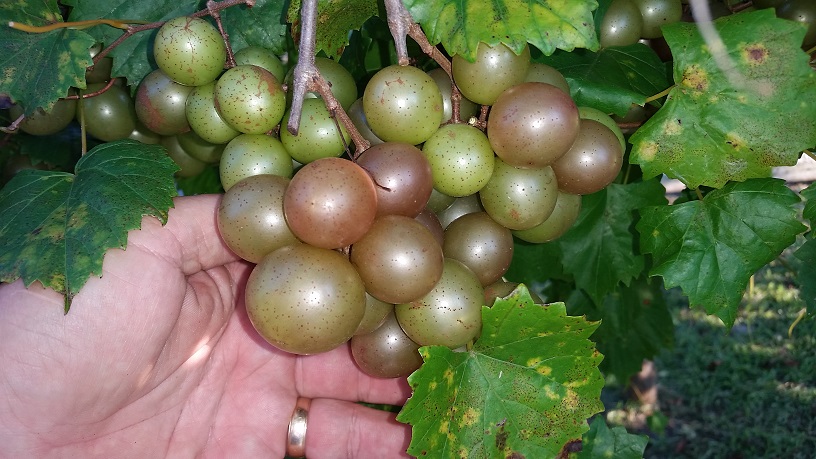
by Erik Lovestrand | Aug 27, 2020
When we moved to the Florida Panhandle in 1989 and bought a house in Wakulla County, my wife and I inherited a grape arbor that was planted by the original builder of the home many years previous. It consisted of three 4×4 posts with cross pieces at the top and a run of heavy gauge wire out near the ends of each cross piece. Maintenance had been lacking for some years so the vines had grown into a massive tangle which at first glance, I surmised I would end up cutting down to help improve the appearance of the property. Well, as is often the case, timing is everything and the existence to this day of that grape arbor, is due to the fact that it was late summer and the vines had some fruit on them. It only took one taste of a sweet, flavorful black muscadine grape to decide they were worth keeping. Little did I know what I was in for though, when it came to properly managing this “wildling” for a productive, beautiful arbor; one that now provides many culinary options, as well as a pleasing, eye-catching aspect in our home landscape.
After looking closer at the vines, it appeared that there were two different species of grapes growing. The very dark purple (almost black) muscadines, were dwarfed by much larger greenish-bronze grapes at one end of the arbor. I now know that these grapes are typically referred to as scuppernongs by most locals and they are actually the same species as the dark grapes. In fact, Vitus rotundifolia is the scientific name for our native wild grapes that have a range from Florida to New Jersey in the east, and west to Texas and Oklahoma. The fruits of this species can be bronze, black or red, depending on the cultivar and they are the same species I remembered picking from wild vines as a youth, which ranged in size from ¼ to ½ inch and were often quite tart. Currently, there are about 150 cultivars of muscadine grapes grown for their fruit and their innate resistance to pests and diseases.
The reason for the two varieties on our grape arbor had to do with the fact that many muscadines produce only pistillate flowers and require pollen from another variety to produce fruit. A few varieties have perfect flowers and can produce fruit on their own, notably Carlos and Noble. Writings about these native grapes date back to the early 1500’s as early explorers of the Cape Fear River Valley in modern-day North Carolina described its abundance and pleasing qualities. The common name “scuppernong” is derived from the Scuppernong River in North Carolina but the name has many variations depending on the locale (scuplin, scufalum, scupanon, scupadine, scuppernine, scupnun, and scufadine). The word “scuppernong” comes from the Algonquian “askuponong,” meaning “place of the askupo,” which is the sweet bay tree (Magnolia virginiana). Cultivation has been recorded as early as the 17th century and with over 100 years of breeding, several bronze cultivars such as Carlos, Doreen, Magnolia and Triumph, are distinguished by having perfect flowers. There is one particular vine on Roanoke Island North Carolina that is considered by many to be the “Mother Vine” for all modern day varieties. This vine has been cultivated for around 400 years, to-date.
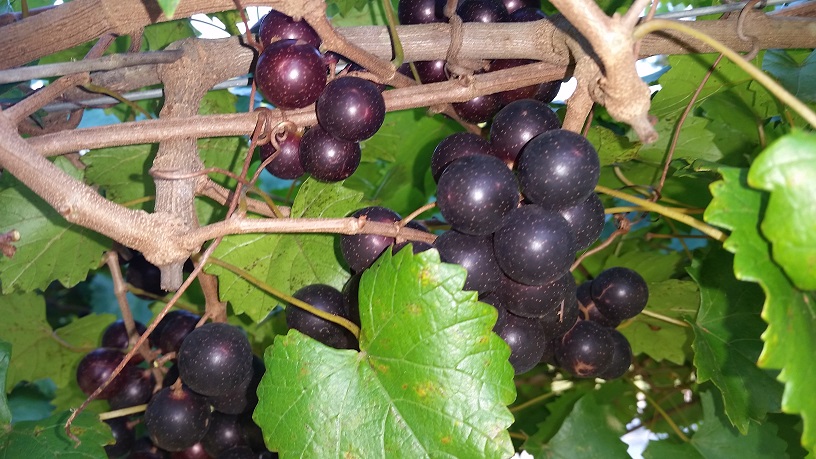
Dark purple muscadine grapes are often called “black grapes.”
If by this time, you are working up a craving for a taste of muscadines, you are not alone because late-summer is the peak production period for many vines around the region. If you do not have your own vines, you are still able to get these grapes at several places around our area. Visit this link for a list of wineries and vineyards in Florida, some of which run u-pick operations. Or you may even have a nearby neighbor with an abundance of fruit and generosity. Some cultivated varieties are suitable for table fare as they have fewer seeds and thinner skins. The tougher-skinned varieties are suitable for jellies, jams, grape butter, and wine making. Bronze scuppernongs produce a very light-colored wine with a mild fruity flavor, while the dark purple muscadines derive a dark reddish, and stronger flavored wine. No matter the type of muscadine, they all provide important habitat and food for many wild critters as well. Thankfully, they generally produce enough bounty to go around and I never begrudge the opossums, raccoons, squirrels and birds their share of the blessing.
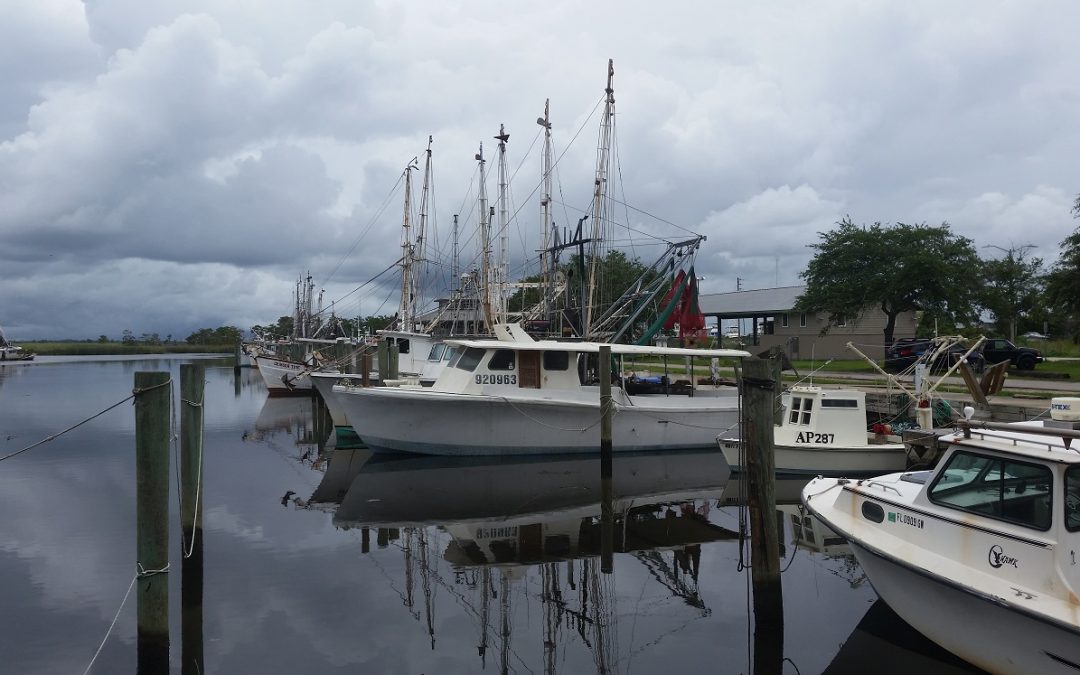
by Erik Lovestrand | Jul 31, 2020
We won’t see it tomorrow… but desperately needed funds for a hard-hit fishing industry are on the way. Congress has allocated $300 million in relief funds for losses suffered by various fishery-related businesses as a result of the COVID-19 pandemic. It comes as part of the $1.8 trillion CARES Act, which focuses on supporting businesses and individuals who have had financial losses during these difficult times.
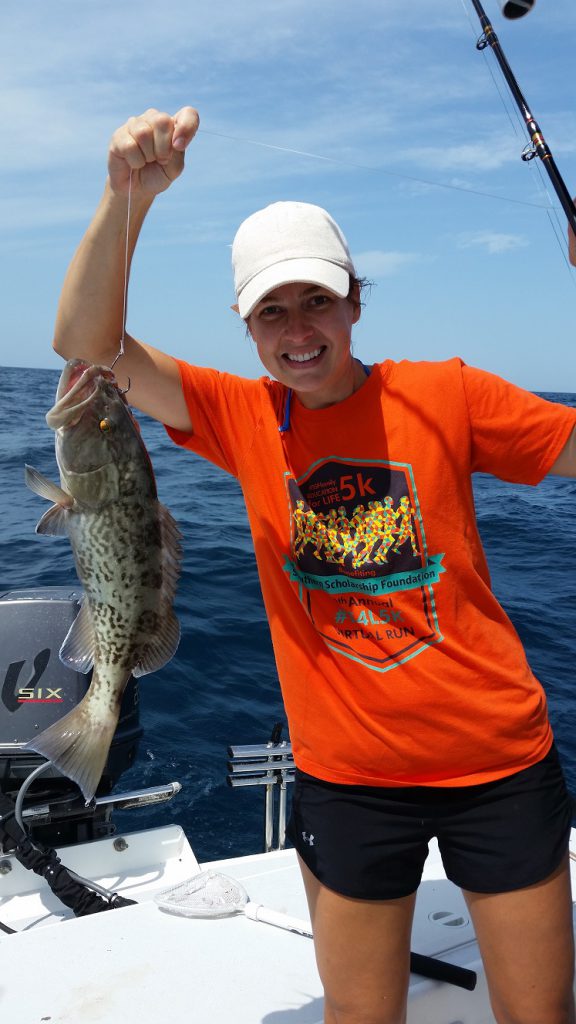
The Charter Fishing Industry was Impacted as People Stopped Travelling.
To allocate the Sec. 12005 funds, NOAA Fisheries used readily available multi-year averages to estimate the total average annual revenues from commercial fishing operations, aquaculture firms, the seafood supply chain (processors, dealers, wholesalers and distributors) and charter fishing businesses from each coastal state, Tribe, and territory. Florida’s share worked out to be $22.4 million for eligible applicants, which includes licensed commercial fishers, seafood wholesale dealers, charter fishing businesses, and aquaculture use certificate holders that are live-rock or bivalve producers. Applicants must be able to document at least a 35% loss of revenue between Jan-May 2020 as compared to the average of the previous five years during the same period.

Oyster Farmers were Dramatically Impacted when Restaurants Closed.
The Florida Fish and Wildlife Conservation Commission received public input during July and will be submitting Florida’s plan for approval to NOAA in early August. After NOAA approval, the FWC will be administering the application and approval process, while the Atlantic States Marine Fisheries Commission will be sending checks directly to successful applicants. This supportive funding will be in the form of a grant and will not require repayment.
To see the FWC’s draft spending plan that will be going to NOAA click HERE. If you would like more information about the CARES Act and the FWC’s role in this effort please visit their website at this LINK. If you think you might be eligible for these funds, don’t wait for the 30 day application period to open (planned for October 2020) before doing your research on this relief funding. Go now to the FWC spending plan so you can begin preparing the documentation that will be required. With the impacts sustained from Hurricane Michael and now the virus, it is hard to imagine an industry sector in our Panhandle region that is more in need of help.
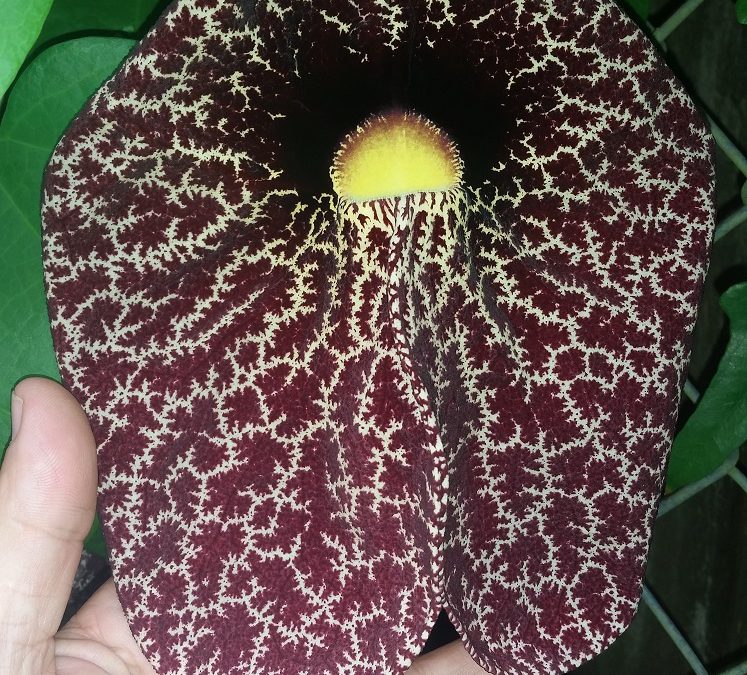
by Erik Lovestrand | Jul 3, 2020
Most people have heard about bug-trapping plants that sustain themselves by digesting and absorbing nutrients from bugs that they catch. This gives them the ability to grow in soils of low fertility that most other plants cannot tolerate. Good examples of this in our Florida Panhandle area include several species of pitcher plants, Venus flytraps (non-native), bladderworts, sundews and butterworts. Some trap their unsuspecting prey by “trickery” with the temptation of sweet but sticky droplets. Others draw prey by the allure of various scents and as the bugs crawl down a narrow passage for the “treat”, one-way hairs prevent them from crawling back out; the “trick.”
One-way hairs is the strategy employed by the Dutchman’s Pipe (Aristolochia littoralis), surely one of the oddest looking flowers on the planet. Also called the “calico flower,” this non-native species of Aristolochia, superficially resembles the Dutchman’s pipe that the famed Sherlock Holmes smoked.
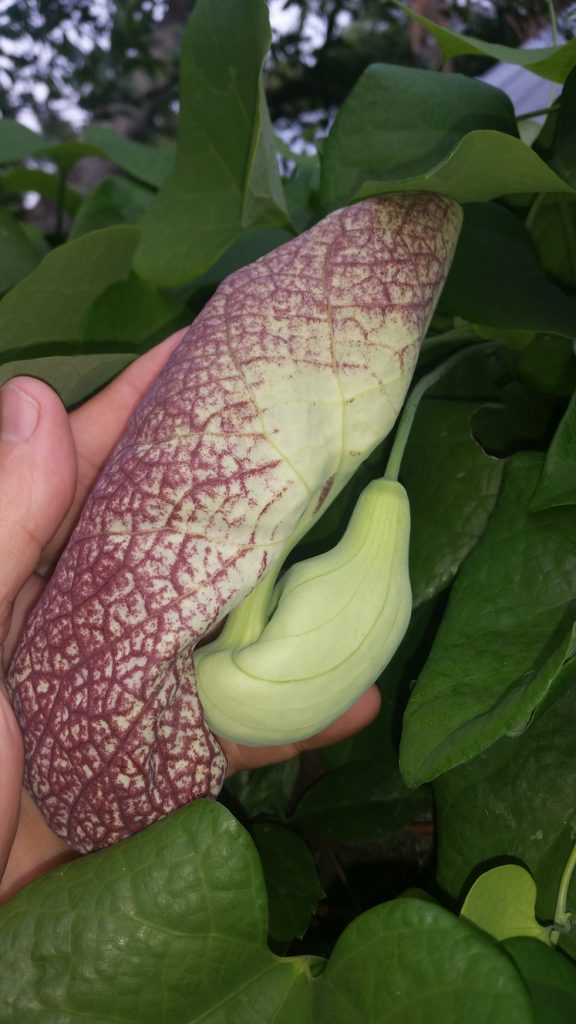
A side-view of the still-closed petals and bulbous reproductive chamber.
The plant is listed as a category II invasive on the Florida Exotic Pest Plant Council’s 2017 List of Invasive Plant Species. Florida also has three native species of Aristolochia, some of which are important larval foods for the pipevine swallowtail. However, there are several non-natives that are actually toxic to butterfly larvae. All of the plants contain a chemical compound called Aristolochic acid, which is considered a strong carcinogen and has been linked to cancer in people who have used this plant as an herbal remedy. The plant has also been found to be a potent kidney toxin and many people have required renal transplants or dialysis as a result of using herbal remedies containing aristolochic acids.
Aristolochia is not alone in the world of bug attracting plants or fungi when it uses a fragrance resembling rotting meat as bait. The unique feature of this plant comes in the trapping strategy that is employed. When a fly is lured down the one-way, hairy tube into the bulbous chamber that serves to hold it’s captor, the flowers reproductive structures are encountered. During the fly’s exploration of the chamber, with no way out, pollen granules adhere to the fly’s body. Amazingly, within a day or so, the stiff hairs blocking the tubular entrance to the prison gradually relax or breakdown, allowing the fly to escape. Scientists who study these flowers all concur that a fly must have a very short memory because it isn’t long before the recent captor ventures into another Aristolochia trap to complete the flower’s pollination process.
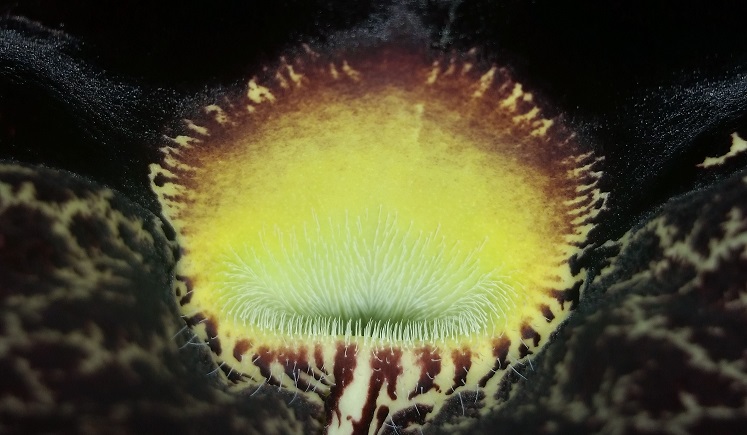
Tiny hairs lining the tube leading to the chamber prevent escape, for a time.
The flower itself is an amazing structure of graceful lines, purplish-brown calico patterns and a bulbous reproductive chamber. However, the story behind the marvelous reproductive strategy of the plant is the hidden gem. Be aware though, that this is not a plant that would be recommended for our Panhandle flower gardens due to its habit of invading wildlands. Oh, now that you’ve struggled through this entire article trying to pronounce Aristolochia in your head, here is how you say it: uh-wrist-oh-low-kee-uh. Good luck with that.
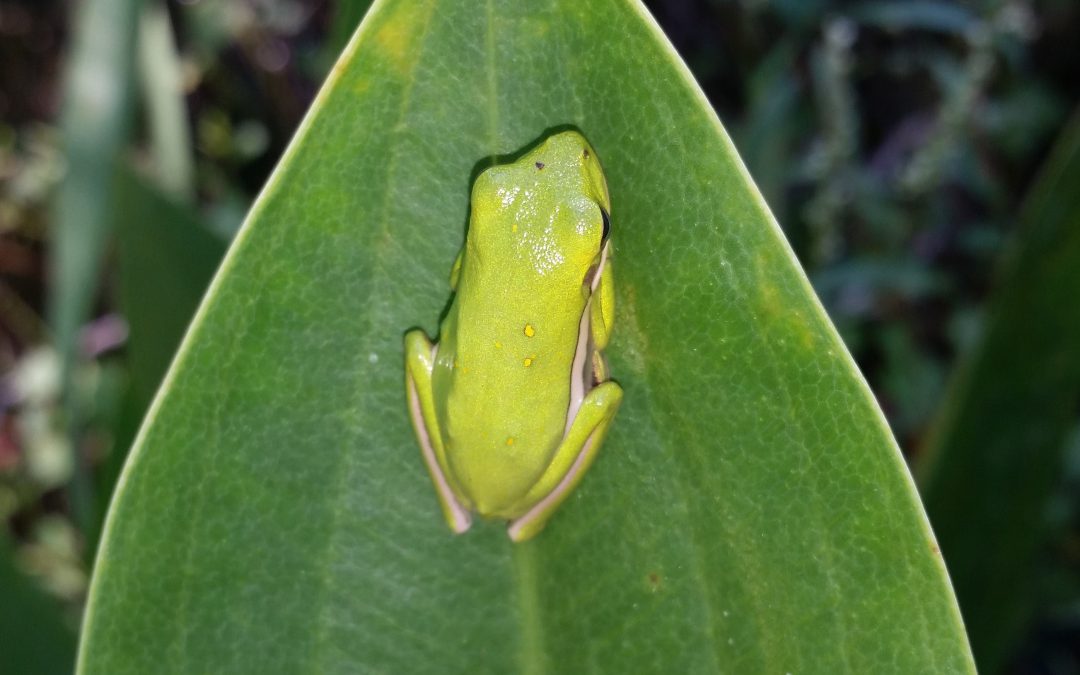
by Erik Lovestrand | Jun 4, 2020
WOW… is all I can say, when I step outside at night of late and become immersed in the spectacular chorus of calls from breeding frogs and toads near my Wakulla County residence. The sound reverberates to the level where it sometimes feels like it is echoing inside one’s head. Recent heavy rains have awakened local species to the notion that there is no time like the present for pro-creation; given the fact that many of the shallow, depressional wetlands in our region will only contain water for a short window of time.
This may seem like a drawback to the life style of frogs and toads that depend on these wetlands but nature has a way of surprising us with incredible adaptations for survival. For instance, the eastern spadefoot toad (Scaphiopus holbrookii) can actually survive through several years with no water available for raising their young. They do this by remaining buried in the ground, only emerging after heavy rains that collect in depressions. Tadpoles metamorphose into small toads within 28 days so by the time the pool goes dry they are likely long-gone. Female spadefoots will lay over 2,000 eggs at a time so the number of progeny that can emerge from a small depressional wetland is phenomenal. I recall seeing black stains across roadways all over the County about a month after one of our tropical storms. Baby spadefoot toads were dispersing by the millions from hundreds of shallow pools across the region and local roadways were one of the hazards they faced on their journey.
Another advantage to amphibians breeding in ephemeral (temporary) wetlands has to do with the fact that there are no fish to prey on the tadpoles. This is not a requirement for all species, as some have chemical defenses (bad taste) that limit predation, but others could not successfully breed in permanent bodies of water.
Some of the species I have heard calling lately include squirrel treefrogs, green treefrogs, Cope’s gray treefrogs, southern toads, cricket frogs, and a few others I have not identified yet. If you have never made an effort to identify the night calls of frogs and toads, you don’t know what you are missing in your local environment. Some are quite difficult to separate but many of very distinct and once you put the call with a name you won’t ever forget it. Take a moment to listen to one of my favorites, the southern toad; the origin of a beautiful, high-pitched trill that you most likely have never paid much attention to. This website (The Frog Blog) is a great resource to learn more calls. Be sure to listen also to the southern cricket frog call that sounds like two marbles clacked together, and Copes’ gray treefrog, which many might mistake for a bird as they call from high in the tree canopy.
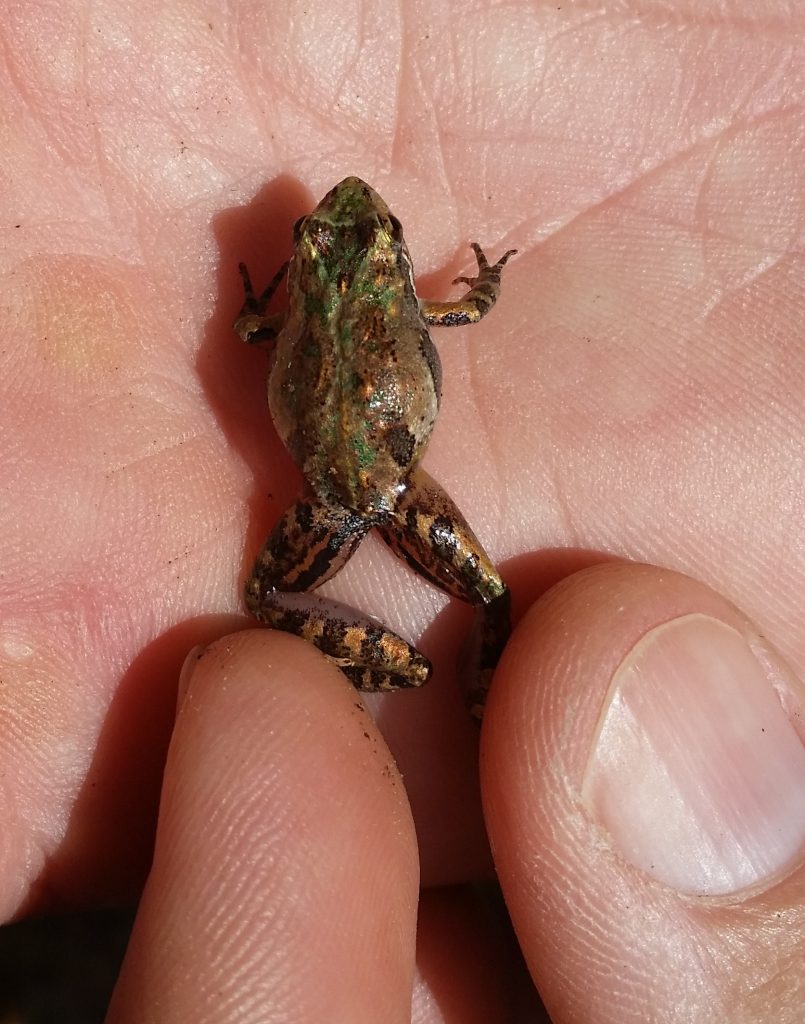
Cricket frogs are one of the smallest vertebrates on the planet.
The cacophony of sounds on a warm summer’s night can seem chaotic and random but if you spend a little time sorting out the musicians, you are sure to develop a deeper appreciation of the symphony, along with a better understanding of the well-orchestrated cycles of nature in your Panhandle backyard.
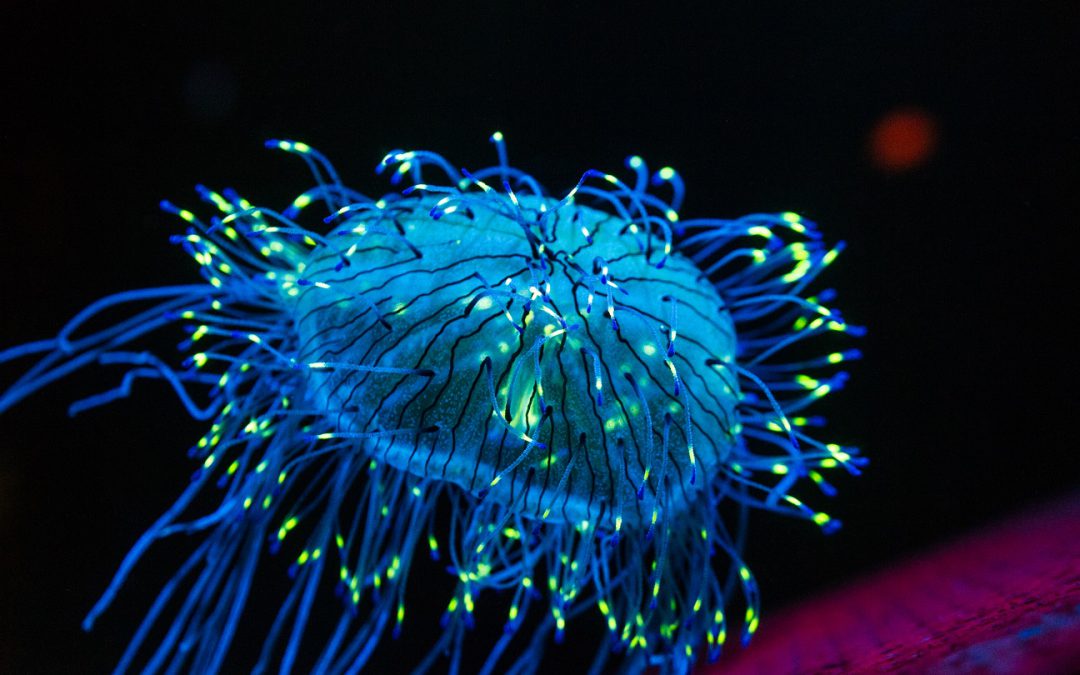
by Erik Lovestrand | Aug 16, 2019
If you like summer fireworks events, there is a great show ongoing during our warm summer months that you shouldn’t miss. Find an unlit dock along our coastal environs and take the time to pause, get down on your knees, and gaze into the starry… water. Our night skies are quite impressive in their own right, but our night waters will also put on an amazing show of glowing critters and flashing lights if you take the time to notice. Thousands of different marine organisms have the ability to produce light and the purposes served by this trait are many. Some animals use this tactic as camouflage and others to stand out for one reason or another. Being seen by others can assist with predation (luring), defense (startling or warning), or even reproduction (attracting a mate).
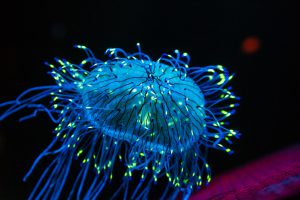
Thousands of marine creatures create their own light, including many jelllyfish
Bioluminescence is the most accurate term for light emitted by living organisms; although sometimes you will hear it referred to as fluorescence or phosphorescence. Fluorescence however, is the term describing something that absorbs light energy from an external source and then almost immediately re-emits it. When the external source goes away, so does the fluorescence; i.e. it doesn’t keep going in the dark. Phosphorescence describes when something absorbs light energy from an external source and then slowly re-emits it over a longer timeframe, i.e. glowing stickers. In contrast to these other terms, bioluminescence results from a chemical reaction within the body of an organism. The trigger mechanisms can be quite varied in nature and some are even directly controlled by linkages with an animal’s brain and nervous system. Other times the light is triggered simply by a physical disturbance. This is the most common phenomenon observed by people as the water seems to sparkle from a boat’s wake at night or waves breaking in the surf. One of my earliest memories of this was as a teenager in the Keys while wading along the shore at night. Each splash would trigger a shower of sparks.
So, what is taking place to create this chemical reaction that gives off light? Well, scientists have learned a lot about it but still don’t have all of the answers regarding the incredible variety of ingredients and processes involved in the bioluminescent realm. In general, a molecule called luciferin is involved and when exposed to oxygen, it gives off light. An enzyme named luciferase acts as a catalyst to help speed up the reaction. There are apparently many types of luciferins utilized by different animals; and I’m guessing, many variations on the actual luciferases involved too.
During summertime the warm waters of the Gulf and our coastal estuaries are rich with planktonic life. If you look close at a dock post beneath the water you will see continual, tiny flashes being triggered as water moves around the stationary post. When you walk down the dock (very carefully, without a flashlight), you can also see streaks of light from startled fish swimming away. This light is emitted by single-celled dinoflagellates that are triggered by a disturbance near them. One fascinating account I’ve read, told the story of Jim Lovell (Apollo 13 astronaut), who used bioluminescence to find his way safely home. When the navigation equipment failed at night in the navy plane he was flying, he was able to turn off his cockpit lights and see the glowing wake from his carrier and follow it. I’m sure he was forever grateful to the tiny marine creatures that made this possible! If you can get to a coastal dock near you this summer, be sure to turn out the lights, and look down in the water for a spectacular, miniature fireworks show. No earplugs required.












